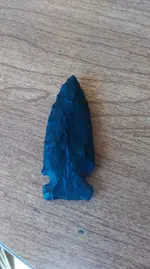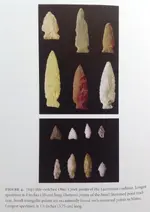You are using an out of date browser. It may not display this or other websites correctly.
You should upgrade or use an alternative browser.
You should upgrade or use an alternative browser.
Maine point
- Thread starter mainejman
- Start date
willjo
Bronze Member
- Joined
- Apr 30, 2015
- Messages
- 1,070
- Reaction score
- 2,033
- Golden Thread
- 0
- Location
- Twin City, Ga.
- Detector(s) used
- Garrett GTA 350 and Garrett ace 150
- Primary Interest:
- All Treasure Hunting
Nice point, is that river stain or natural color?
joshuaream
Silver Member
- Joined
- Jun 25, 2009
- Messages
- 3,170
- Reaction score
- 4,512
- Golden Thread
- 0
- Location
- Florida & Hong Kong
Well made point, how big is it?
creekhunter
Bronze Member
- Joined
- Dec 14, 2007
- Messages
- 1,237
- Reaction score
- 572
- Golden Thread
- 0
- Location
- Cincinnati, Ohio
- Detector(s) used
- Radio Shack
- Primary Interest:
- All Treasure Hunting
Nice side notch!
Trooper733
Sr. Member
- Joined
- Apr 3, 2013
- Messages
- 388
- Reaction score
- 315
- Golden Thread
- 0
- Location
- Eastern Oklahoma
- Detector(s) used
- Whites V3i,Whites DFX, Whites TRX, Garrett Pro Pointer
- Primary Interest:
- Other
Very nice find! Can you add a common item or scale next to it for size comparison?
The Grim Reaper
Gold Member
- Joined
- Apr 3, 2008
- Messages
- 7,805
- Reaction score
- 7,068
- Golden Thread
- 0
- Location
- Southern Ohio
- Primary Interest:
- All Treasure Hunting
If there is grinding on the base it is an Early Archaic Side Notch type. I'm surprised no one has said Big Sandy yet since that's what most of these types are classified as.
Great looking Point. Congrats on the find.
Great looking Point. Congrats on the find.
NCPeaches
Silver Member
- Joined
- Mar 24, 2013
- Messages
- 2,881
- Reaction score
- 2,999
- Golden Thread
- 0
- Location
- Western Piedmont North Carolina
- Primary Interest:
- All Treasure Hunting
That's beautiful!
Charl
Silver Member
- Joined
- Jan 19, 2012
- Messages
- 3,076
- Reaction score
- 4,773
- Golden Thread
- 0
- Location
- Rhode Island
- Primary Interest:
- Relic Hunting
If there is grinding on the base it is an Early Archaic Side Notch type. I'm surprised no one has said Big Sandy yet since that's what most of these types are classified as.
Great looking Point. Congrats on the find.
It's a nice example of the Northeast correlate to Big Sandy, an Otter Creek point:
New York State Museum - Projectile Point Type Collection
monsterrack
Silver Member
- Joined
- Apr 15, 2013
- Messages
- 4,419
- Reaction score
- 5,827
- Golden Thread
- 0
- Location
- Southwest Mississippi
- Detector(s) used
- Garrett, and Whites
- Primary Interest:
- All Treasure Hunting
Nice find for sure

The Grim Reaper
Gold Member
- Joined
- Apr 3, 2008
- Messages
- 7,805
- Reaction score
- 7,068
- Golden Thread
- 0
- Location
- Southern Ohio
- Primary Interest:
- All Treasure Hunting
It's a nice example of the Northeast correlate to Big Sandy, an Otter Creek point:
New York State Museum - Projectile Point Type Collection
Same time period, but the Otter Creek resembles the Brewerton family more than a Big Sandy in my opinion.
Charl
Silver Member
- Joined
- Jan 19, 2012
- Messages
- 3,076
- Reaction score
- 4,773
- Golden Thread
- 0
- Location
- Rhode Island
- Primary Interest:
- Relic Hunting
Same time period, but the Otter Creek resembles the Brewerton family more than a Big Sandy in my opinion.
Yes, it does, and it is closely related to, and found on the same sites, as the Brewerton complex. There are a great many Otter Creek sites on the Penobscot as well. Noel Justice, in "Stone Age Spear and Arrow Points of the Midcontinental and Eastern United States" describes Otter Creek as a Northeastern correlate to the Large Side Notch cluster that he begins with the Big Sandy type. In addition, the artifact guide published by the Massachusetts Archaeological Society also describes the Otter Creek style as a morphological correlate of Big Sandy. Ritchie described Otter Creek as the first style in the Laurentian tradition or series, which would include Otter Creek, all the Brewerton styles, and ended with Normanskill points.
Charl
Silver Member
- Joined
- Jan 19, 2012
- Messages
- 3,076
- Reaction score
- 4,773
- Golden Thread
- 0
- Location
- Rhode Island
- Primary Interest:
- Relic Hunting
The Otter Creek point is interpreted as a morphological correlate of Big Sandy. It is not suggested that they are the same point going by different names, although it is fair and reasonable to inquire as to the relationship of one to the other. Noel Justice's books are an excellent alternative to regional-based typologies, because he adopts the "point cluster" approach that permits easier comparison of styles across regions, whereas most other typologies are regionally based. And, with the latter approach, the same point can actually go by different names in different geophysical regions. At any rate, I notice more and more collectors buying into Justice's approach to typology. He includes both Big Sandy and Otter Creek in his "Large Side Notch Cluster", and commences that cluster with Big Sandy points.
The guide put out by the MAS lists Big Sandy and Raddatz as "morphological" correlates, which is why I suggested that in the first place. It's an old guide, but still useful; it's actually an early effort to allow comparison of our New England styles with similar styles outside this region.
Lithic Net states that Otter Creek points are not found in Maine. Not true. Two population groups in Maine at that time. The "small stem point" people on the coast developed the so called Moorehead Complex of the Maritime Archaic. The Laurentian tradition dominated in interior Maine, esp. east of the Penobscot. In fact, some of the best dates for Otter Creek points have been obtained at Maine sites. 5200-4500 BP, and the beginning of the Laurentian Tradition. Photo shows the projectile points of the 2 cultural traditions present in Maine during the Middle-Late Archaic. Otter Creek and other Laurentian tradition points in interior Maine, and so-called Small Stem Tradition along coastal Maine. From "The Swordfish Hunters"(2012) by Maine archaeologist Bruce Borque.
The guide put out by the MAS lists Big Sandy and Raddatz as "morphological" correlates, which is why I suggested that in the first place. It's an old guide, but still useful; it's actually an early effort to allow comparison of our New England styles with similar styles outside this region.
Lithic Net states that Otter Creek points are not found in Maine. Not true. Two population groups in Maine at that time. The "small stem point" people on the coast developed the so called Moorehead Complex of the Maritime Archaic. The Laurentian tradition dominated in interior Maine, esp. east of the Penobscot. In fact, some of the best dates for Otter Creek points have been obtained at Maine sites. 5200-4500 BP, and the beginning of the Laurentian Tradition. Photo shows the projectile points of the 2 cultural traditions present in Maine during the Middle-Late Archaic. Otter Creek and other Laurentian tradition points in interior Maine, and so-called Small Stem Tradition along coastal Maine. From "The Swordfish Hunters"(2012) by Maine archaeologist Bruce Borque.
Attachments
Last edited:
Charl
Silver Member
- Joined
- Jan 19, 2012
- Messages
- 3,076
- Reaction score
- 4,773
- Golden Thread
- 0
- Location
- Rhode Island
- Primary Interest:
- Relic Hunting
I think one thing that is good to remember, every so often, is that we moderns are creating the typologies. Whatever else the appearance of large side notched points represented in the eastern United States, we can be certain the natives were not calling them Big Sandy points, or Otter Creek points. The actual relationship among these points is too uncertain. But, appearing at about the same time in the archaeological record, it is fair to at least ask if there is a relation between the appearance of Big Sandy, and the appearance in the Northeast of Otter Creek points. But, typology is still largely regionally based, and we have a plethora of names for very similar appearing points. The actual data, the actual points upon which typologies are based, are not artificial. But, try as we may, our typologies will always be somewhat artificial. How often do we find points, only to find ourselves struggling to force them into a recognized type? None of our typologies existed in the past, in the real world. But, IMHO, nothing makes typing points more difficult then basing the descriptions on the region where the point was found. Yes, there were different cultural expressions at different times in different regions. But there were no barriers between regions. No Native American had to refer to typologies when fashioning projectiles.
The Grim Reaper
Gold Member
- Joined
- Apr 3, 2008
- Messages
- 7,805
- Reaction score
- 7,068
- Golden Thread
- 0
- Location
- Southern Ohio
- Primary Interest:
- All Treasure Hunting
I think one thing that is good to remember, every so often, is that we moderns are creating the typologies. Whatever else the appearance of large side notched points represented in the eastern United States, we can be certain the natives were not calling them Big Sandy points, or Otter Creek points. The actual relationship among these points is too uncertain. But, appearing at about the same time in the archaeological record, it is fair to at least ask if there is a relation between the appearance of Big Sandy, and the appearance in the Northeast of Otter Creek points. But, typology is still largely regionally based, and we have a plethora of names for very similar appearing points. The actual data, the actual points upon which typologies are based, are not artificial. But, try as we may, our typologies will always be somewhat artificial. How often do we find points, only to find ourselves struggling to force them into a recognized type? None of our typologies existed in the past, in the real world. But, IMHO, nothing makes typing points more difficult then basing the descriptions on the region where the point was found. Yes, there were different cultural expressions at different times in different regions. But there were no barriers between regions. No Native American had to refer to typologies when fashioning projectiles.
Exactly, which is why I normally just stick with calling them Early Archaic Cluster Side Notch types.
Dirt fishing Wolf
Bronze Member
- Joined
- Dec 29, 2009
- Messages
- 2,210
- Reaction score
- 504
- Golden Thread
- 0
- Location
- G P, Illinois
- Detector(s) used
- DFX, Nokta Makro Simplex +
- Primary Interest:
- All Treasure Hunting
Great point!!
Similar threads
- Replies
- 17
- Views
- 682
- Replies
- 7
- Views
- 771
Users who are viewing this thread
Total: 1 (members: 0, guests: 1)
Latest Discussions
-
-
-
-
Confederate Gold from the Civil War was Found in a Shocking Place
- Latest: diamonddave
-




